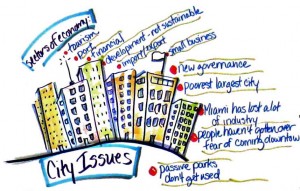
I’ll give you the punchline first:
I’m still blown away by the paparazzi snapping pictures of your work. Everyone at the conference loved it. It was a huge hit. I haven’t worked with someone of your skill before. You have so much flexibility, a great sense of humor and you know how to adapt to a situation.
That’s from my new buddy, Joel Mills who runs the American Institute of Architects (AIA) program Communities by Design. Joel is very much one of my right people.
Here’s the story.
Joel found me. We had a phone call. He hired me. I flew to Miami having only the slightest idea about what I would be doing. Seriously, it was the first gig where I felt entirely clueless. Not that I need a ton of background going in, but it helps to know where I need to be and when, and what’s going to happen.
But I wasn’t worried. I do yoga. I’m flexible.
And hey, I was in Miami. I loved the mission of this program. AIA put me up at The Epic which lived up to its name. *swoon* Have I mentioned my thing for high-end boutique hotels? And there were mojitos. Mojitos!
And Joel and Erin did take very good care of me.
A little background.
AIA’s Communities by Design gives world-class advice and recommendations to communities big to small all over the country that want to Revision. Repurpose. Place-make. And Redefine a specific place.
This whole project got me excited because one of my five lives (if you know the work of Barbara Sher) is an architect/designer/city planner because I would love the challenge of playing and designing at that scale.
A river gives birth to a city.
Our project was the Miami River Corridor—the ancient birthplace of the city where the first Indian settlement in South Florida existed.
The Miami River Corridor has a rich history that’s largely unknown. Part of it is a designated heritage site. There are old neighborhoods. Historic hotels. Protected Indian sites. All kinds of relics from a long time ago.
It’s also a working waterfront with marinas and a port.
The river winds through neighborhoods and public parks, some of which have ball fields and get used, some of which don’t.
It’s also polluted but getting better. Kayakers are using it more and more for day trips.
It has cultural significance. Rituals are performed in its waters like baptisms and voodoo sacrifices of chickens.
Its many things to many people. It’s also hard to get to. Most people don’t even see it except from a bridge as they are driving over. And plenty of people have never been on it, in it or beside it.
So there are issues of identity. And place. Meaning. Use. And what the river wants to be now. And issues about the health of the river itself and the communities along its banks.
Assemble the crackerjack team.
Enter into this story a brilliant team assembled by the AIA that included:
- an architect
- a landscape architect
- an economist
- a port operations expert
- a person with multi-government jurisdiction experience
- a planner who specializes in pedestrian and bike mobility
And me. With my environmental political experience. My current work as the board chair of an organization dedicated to protecting Georgia’s rivers. And being the daughter of a former 20-year Florida marina owner who was very involved in the controversial issue of protecting the manatees years ago.
For several days the team listens, really listens, to key stakeholders. They take tours on the river and in the surrounding neighborhoods. They get their feet on the ground. They experience the place with fresh eyes. They ask questions.
In a long afternoon meeting we dialogued with the MRC Commission about their dreams, concerns and issues. Because of a mix-up, I wasn’t able to capture the meeting live on a visual map. So I took copious notes—relying on my journalism experience like I did with the fine folks at AGU— and worked up a mural later that day.
My favorite part was the public dialogue meeting where individuals who cared about the river were asked to share their vision for the future of the river corridor. We asked them what they valued about the river. Some of the answers were:
- the continuity of history
- living on the river
- economic development
- tourism
- unique neighborhoods
- accessibility
We talked about all the ways it was currently being used. What the impediments were to making it a wonderful place. And then created the vision of what it could be.
My part was pivotal here because as I wrote and drew the ideas people shared, I allowed their vision to flow through me and into the paper so they could see how wonderful, special and significant this river is in all its facets. It was all right there in big gorgeous Technicolor. And they were wowed.
They felt heard, which was the most important part. As I often say,
Listening is an act of love.
In fact, the team got an email later from someone at the public meeting commending them for really listening.
The all-nighter commences.
The next step of the team’s process is kind of like cramming for your exams. They hole up in the hotel conference room and get to work. They think. They write. They compare ideas. They write some more.
Other folks come in to help. The youngsters who are tech savvy make maps and drawings and scale models. This goes on for 36 hours, mostly straight.
A room full of brains on fire. Culminating in a beautifully detailed 48- page report with recommendations galore. Take a peek. My visual maps are on page 16. (This is also a great example of how my client repurposed the murals created during the live event.)
All this work was presented at AIA’s annual conference. It created quite a buzz. People swarmed the murals to take photos.
I know those architects and I are going to work together again real soon. There might not be mojitos but we’ll make due with another local beverage. Aquavit perhaps? Ouzo?
